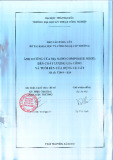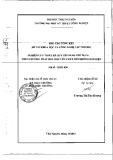
RESEARC H ARTIC L E Open Access
Identification and characterization of wheat long
non-protein coding RNAs responsive to powdery
mildew infection and heat stress by using
microarray analysis and SBS sequencing
Mingming Xin
1,2†
, Yu Wang
1,2†
, Yingyin Yao
1,2†
, Na Song
1,2
, Zhaorong Hu
1,2
, Dandan Qin
1,2
, Chaojie Xie
1,2
,
Huiru Peng
1,2*
, Zhongfu Ni
1,2
and Qixin Sun
1,2,3*
Abstract
Background: Biotic and abiotic stresses, such as powdery mildew infection and high temperature, are important
limiting factors for yield and grain quality in wheat production. Emerging evidences suggest that long non-protein
coding RNAs (npcRNAs) are developmentally regulated and play roles in development and stress responses of
plants. However, identification of long npcRNAs is limited to a few plant species, such as Arabidopsis, rice and
maize, no systematic identification of long npcRNAs and their responses to abiotic and biotic stresses is reported in
wheat.
Results: In this study, by using computational analysis and experimental approach we identified 125 putative
wheat stress responsive long npcRNAs, which are not conserved among plant species. Among them, some were
precursors of small RNAs such as microRNAs and siRNAs, two long npcRNAs were identified as signal recognition
particle (SRP) 7S RNA variants, and three were characterized as U3 snoRNAs. We found that wheat long npcRNAs
showed tissue dependent expression patterns and were responsive to powdery mildew infection and heat stress.
Conclusion: Our results indicated that diverse sets of wheat long npcRNAs were responsive to powdery mildew
infection and heat stress, and could function in wheat responses to both biotic and abiotic stresses, which
provided a starting point to understand their functions and regulatory mechanisms in the future.
Background
The developmental and physiological complexity of
eukaryotes could not be explained solely by the number
of protein-coding genes [1]. For example, the Drosophila
melanogaster genome contains only twice as many
genes as some bacterial species, although the former is
far more complex in its genome organization than the
latter. Similarly, the number of protein-coding genes in
human and nematode is extremely close. A portion of
this paradox can be resolved through alternative pre-
mRNA splicing [2]. In addition, post-translational modi-
fications can also contribute to the increased complexity
and diversity of protein species [3].
Recent studies suggest that most of the genome are
transcribed, among the transcripts only a small portion
encode for proteins, whereas a large portion of the tran-
scripts do not encode any proteins, which are generally
termed non-protein coding RNAs (npcRNA). For exam-
ple, transcriptome profiling in rice (Oryza sativa)indi-
cates that there are about 8400 putative npcRNAs,
which do not overlap with any predicted open reading
frames (ORFs) [4]. These npcRNAs are subdivided as
housekeeping npcRNAs (such as transfer and ribosomal
RNAs) and regulatory npcRNAs or riboregulators, with
the latter being further divided into short regulatory
npcRNAs (<300 bp in length, such as microRNA,
siRNA, piwi-RNA) and long regulatory npcRNAs
* Correspondence: penghuiru@cau.edu.cn; qxsun@cau.edu.cn
†Contributed equally
1
State Key Laboratory for Agrobiotechnology and Key Laboratory of Crop
Heterosis and Utilization (MOE) and Key Laboratory of Crop Genomics and
Genetic Improvement (MOA), Beijing Key Laboratory of Crop Genetic
Improvement, China Agricultural University, Beijing, 100094, PR China
Full list of author information is available at the end of the article
Xin et al.BMC Plant Biology 2011, 11:61
http://www.biomedcentral.com/1471-2229/11/61
© 2011 Xin et al; licensee BioMed Central Ltd. This is an Open Access article distributed under the terms of the Creative Commons
Attribution License (http://creativecommons.org/licenses/by/2.0), which permits unrestricted use, distribution, and reproduction in
any medium, provided the original work is properly cited.

(>300 bp in length). With the identification of micro-
RNAs and siRNAs in diverse organisms, increasing evi-
dences indicate that these short npcRNAs play
important roles in development, responses to biotic and
abiotic stresses by cleavage of target mRNAs or by inter-
fering with translation of target genes [5-9].
Long npcRNAs are transcribed by RNA polymerase II,
polyadenylated and often spliced [10]. Studies in mice
and human suggested that at least 13% and 26% of the
unique full-length cDNAs, respectively, are thought to
be poly(A) tail-containing long npcRNAs [11-13]. Emer-
ging evidences also suggest that long npcRNAs are
developmentally regulated and responsive to external
stimuli, and play roles in development and stress
responses of plants and disease in human. For example,
some long npcRNAs are regulated in various stresses in
plants and animals [9,14-16]. In Caenorhabditis elegans,
25 npcRNAs are either over- or under-expressed under
heat shock or starvation conditions [17], while in Arabi-
dopsis, the abundance of 22 putative long npcRNAs are
regulated by phosphate starvation, salt stress or water
stress [18]. In Arabidopsis,longnpcRNA,COOLAIR
(cold induced long antisense intragenic RNA), is cold-
induced FLC antisense transcripts, and has an early role
in the epigenetic silencing of FLC and to silence FLC
transcription transiently [19]. Long npcRNA HOTAIR in
human is reported to reprogram chromatin state to pro-
mote cancer metastasis [20].
Currently, two computational methods are employed
to identify long npcRNAs, genome-based and transcript-
based. Using genomic sequences, more than 200 candi-
date long npcRNAs were predicted in Escherichia coli
[21], and at least 20 long npcRNA genes have been
experimentally confirmed [22]. In Rhizobium etli,89
candidate npcRNAs are detected by high-resolution til-
ling array, and 66 are classified as novel ones [23].
While using cDNA or EST sequences, a large number
of long npcRNAs are detected in Drosophila, mouse and
Arabidopsis [12,18,24-26].
Up to date, identification of long npcRNAs is limited
to a few plant species, such as Arabidopsis, rice and
maize. To our best knowleage, in wheat no systematic
identification of long npcRNAs is reported. Wheat (Tri-
ticum aestivum, AABBDD, 2n = 42) is the most widely
grown crop plant, occupying 17% of all the cultivated
land, provides approximately 55% of carbohydrates for
world human consumption [27], Biotic and abiotic stres-
ses are important limiting factors for yield and grain
quality in wheat production. For instance, powdery mil-
dew, caused by the obligate biotrophic fungus Blumeria
graminis f. sp. tritici (Bgt), is one of the most devastating
diseases of wheat in China and worldwide and causing
significant yield losses [28]. High temperature, often
combined with drought stress, causes yield loss and
reduces the grain quality [29]. To reduce the damages
caused by biotic and abiotic stresses, plants have evolved
sophisticated adaptive response mechanisms to repro-
gram gene expression at the transcriptional, post-
transcriptional and post-translational levels [30].
Recently, transcript profiling has been successfully
employed to determine the transcriptional responses to
powdery mildew infection and heat stress in wheat, and
the results revealed that a number of genes were signifi-
cantly induced or repressed in response to these stresses
[31,32].
In our previous study [33], it was demonstrated that
expression of microRNAs in wheat was regulated by
powdery mildew infection and heat stress, which stimu-
lated us to explore whether long npcRNA was also
responsive to powdery mildew infection and/or heat
stress.Inthisstudy,weperformedagenome-widein
silico screening of powdery mildew infection and heat
stress responsive wheat transcripts in order to isolate a
collection of long npcRNA genes. Combining microarray
analysis and high-throughput SBS sequencing methods,
we totally characterized 125 putative stress responsive
long npcRNAs in wheat, four of them were miRNA pre-
cursors, and one was experimentally verified by northern
blot. Wheat long npcRNAs displayed tissue-specific
expression patterns and their expression levels were
altered in response to powdery mildew infection and/or
heat stress, which suggested that at least a subset of
these newly identified wheat long npcRNAs potentially
play roles in response to biotic and/or abiotic stresses in
wheat.
Results
Identification of powdery mildew infection and heat
stress responsive long npcRNA candidates in wheat
In our previous study, a total of 9744 powdery mildew
infection and 6560 heat stress responsive transcripts
were obtained (with a fold change of at least 2) through
microarray analysis using the wheat Affymetrix Gene-
Chip
®
. In this study, in order to identify the putative
wheat long npcRNAs which were responsive to powdery
mildew and/or heat stress, these stress responsive tran-
scripts were used to characterize the wheat long
npcRNAs. Firstly, these transcripts were annotated by
Harvest program, and 7746 and 5754 transcripts were
identified to be protein-coding genes and therefore were
discarded in further analysis. The remaining transcripts
were then analyzed by Blastx and Blastn, 586 and 406
ESTs with no similarity to protein coding genes or
tRNA and rRNA were retained. Secondly, 125 tran-
scripts with no or short ORFs (less than 80aa) and
polyA-tails were selected as putative long npcRNAs
(Additional file 1), among which 71 were responsive to
powdery mildew infection, and 77 were responsive to
Xin et al.BMC Plant Biology 2011, 11:61
http://www.biomedcentral.com/1471-2229/11/61
Page 2 of 13

heat stress. We found that 23 long npcRNAs responded
to both powdery mildew infection and heat stress
(designated TalnRNA). A total of 48 putative long
npcRNAs were only responsive to powdery mildew
infection (designated TapmlnRNA), and 54 were only
responsive to heat stress (designated TahlnRNA).
Among these putative long npcRNAs, the longest ORF
was 74aa, with an average of 43.5aa (Additional file 1).
In order to validate expression patterns of the long
npcRNAs in response to powdery mildew infection and/
or heat stress, expression patterns of 4 long npcRNAs,
TapmlnRNA19, TapmlnRNA30, TahlnRNA27 and
TalnRNA5, were determined by using quantitative RT-
PCR analysis. Expression levels of TapmlnRNA19 and
TapmlnRNA30 were up-regulated after powdery mildew
inoculation (Figure 1a, b), whereas expression of
TahlnRNA27 and TalnRNA5 were up-regulated after
heat stress (Figure 2a, b), which showed consistent
expression patterns with microarray analysis.
Four long npcRNA transcripts correspond to miRNA
precursors
By mapping miRNAs which were identified from our pre-
viously sequenced six small RNA libraries (S-0h, S-12h,
R-0h, R-12h, TAM-0h, TAM-1h) [33] to the complete
collection of 125 long npcRNAs, we identified that four
transcripts (TalnRNA5, TapmlnRNA8, TapmlnRNA19,
TahlnRNA27) were miRNA precursors. Prediction of the
secondary structure for the four transcripts by using the
Vienna RNA package RNAfold web interface program
showed that these four miRNA precursors had stable
hairpin structures (Additional file 2, 3, 4 and 5).
Among the four long npcRNAs, three (TalnRNA5,
TapmlnRNA19 and TapmlnRNA8) were responsive
to powdery mildew infection. Both TalnRNA5 and
TapmlnRNA19 were the precursors of miR2004, and
TapmlnRNA8 was the precursor of miR2066. It is inter-
esting to note that TapmlnRNA19 and TalnRNA5 were
up-regulated after powdery mildew infection as deter-
mined by qRT-PCR (Figure 1a, 3a), and miR2004 was
also found to be up-regulated based on the small RNA
high throughput sequencing (Figure 3b). To further
determine the expression pattern of miR2004, we per-
formed Northern blot analysis (Figure 3c) which indi-
cated that miR2004 shared similar expression pattern
with the high throughput sequencing.
The heat responsive long npcRNA TahlnRNA27 con-
tained Ta-miR2010 family sequences, and was up-
regulated in ‘TAM107’(heat tolerant cultivar) 1 h after
heat treatment (Figure 2a), whereas Ta-miR2010 was
also statistically up-regulated 1 h after heat stress in the
small RNA databases of ‘TAM107’in our previous study
[33]. The secondary structure and the corresponding
expression pattern indicated that TahlnRNA27 might be
the precursor of miR2010. In addition, the powdery
mildew infection responsive long npcRNA TalnRNA5
(Figure 3a) was found to be also responsive to heat
stress and the expression level was increased in ‘CS’and
‘TAM107’1 h after heat stress (Figure 2b).
Characterization of putative long npcRNAs for siRNA
We found that 16 out of 71 powdery mildew responsive
long npcRNAs gave rise to small RNAs (Additional file
1), and all of them had similar expression pattern in
microarray analysis and SBS sequencing. Most of these
long npcRNAs produced more than one small RNA
family. For example, TapmlnRNA11 comprised three
small RNA family sequences and each had several mem-
bers (Figure 4). The expression level of TapmlnRNA11
in non-inoculated genotypes was quite low, but accumu-
lated to a high level after powdery mildew infection in
JD8 and JD8-Pm30 12hai (Figure 5a). Consistent with
this expression pattern, its corresponding siRNAs were
also up-regulated after powdery mildew infection (Figure
5b) in both genotypes.
For the heat stress responsive long npcRNAs, there
were nine transcripts matching the small RNAs (Addi-
tional file 1). Among them, TalnRNA21 was responsive
to both heat treated and powdery mildew inoculated
wheat leaves, however, the expression pattern was quite
Figure 1 Expression patterns of wheat long npcRNAs
TapmlnRNA19 (a) and TapmlnRNA30 (b) in response to
powdery mildew inoculation (12hai) as determined by qRT-PCR
analysis, S-0H: before Bgt inoculation in susceptible (S)
genotype, S-12H: 12 hrs after Bgt inoculation in S genotype,
R-0H: before Bgt inoculation in resistant (R) genotype, R-12H:
12 hrs after Bgt inoculation in R genotype.
Figure 2 Expression patterns of wheat long npcRNAs
TahlnRNA27 (a) and TalnRNA5 (b) in response to heat stress.
CS-0h: before heat stress treatment for heat susceptible genotype
Chinese Spring (CS), CS-1h: after 1 hour heat stress treatment, TAM-
0h: before heat stress treatment for heat tolerant genotype TAM107
(TAM), TAM-1h: after 1 hour heat stress treatment.
Xin et al.BMC Plant Biology 2011, 11:61
http://www.biomedcentral.com/1471-2229/11/61
Page 3 of 13

different, expression of TalnRNA21 was repressed in
JD8 and JD8-Pm30 12hai (Figure 6a), but up-regulated
after heat stress in ‘CS’and ‘TAM107’(Figure 6b). We
also noted that TalnRNA21 accumulated to a much
higher expression level 1 h after heat treatment in heat
tolerant cultivar as compared to that in heat sensitive
cultivar (Figure 6b).
Long npcRNAs corresponding to SRP and snoRNAs
We found that 52 powdery mildew infection responsive
and 66 heat stress responsive long npcRNAs could exe-
cute their functions in the form of long molecules,
among which 21 transcripts were responsive to both
stress treatments (Additional file 1). Two transcripts,
TalnRNA9 and TalnRNA12, were identified as signal
recognition particle (SRP) 7S RNA variant 1 and 3,
respectively. It was found that the expression of
TalnRNA9 was increased in both JD8 and JD8-Pm30
genotypes 12 hours after infection (hai) (Figure 7a), but
was repressed 1 h after heat treatment in ‘CS’(heat sensi-
tive cultivar) and ‘TAM107’(heat tolerant cultivar) (Fig-
ure 7b). Among the 45 long npcRNAs which were only
responsive to heat stress, three (TahlnRNA12
TahlnRNA23 and TahlnRNA29) were characterized as
U3 snoRNAs, and their expression levels were increased
1 h after heat stress in both ‘CS’and ‘TAM107’(Figure 8)
Histone acetylation of TalnRNA5 and TapmlnRNA19
The histone acetylation levels of TalnRNA5 and
TapmlnRNA19 were detected using antibody H3K9 by
ChIP according to the procedure of Lawrence [34].
ChIP analysis indicated that acetylation levels of
TalnRNA5 and TapmlnRNA19 in the inoculated
JD8 and JD8-Pm30 increased as compared to the non-
inoculated controls (Figure 9).
Small RNAs might influence long npcRNAs expression
Based on our analysis, two SRP 7S RNA variants
TalnRNA9 and TalnRNA12 could be regulated by 24 nt
siRNAs. There were five siRNA families complementarily
matching to the long npcRNAs, among which, three
groups (group I, group II, group III) matched both
TalnRNA9 and TalnRNA12, and other two (group IV
group V) were specific for TalnRNA9 (Additional file 6).
We designed gene specific primers (Additional file 7) and
amplified the antisense strand sequences of TalnRNA9
and TalnRNA12 (anti-TalnRNA9 and anti- TalnRNA12).
It was found that expression levels of TalnRNA9 and
TalnRNA12 were up-regulated after powdery mildew
inoculation in the two genotypes (Figure 10a), whereas
both of the antisense sequences were down-regulated
after powdery mildew inoculation in the two genotypes
(Figure 10b), and negative correlation in expression levels
was observed between sense strand and antisense strand
expression patterns in both JD8 and JD8-Pm30 (Figure
10). In addition, three long npcRNAs, TapmlnRNA11,
TapmlnRNA41 and TapmlnRNA42 also had several
group small sequences matching them, and their expres-
sion patterns could be also regulated by siRNAs.
Wheat putative long npcRNAs displayed tissue-specific
expression patterns
To investigate the expression patterns of long npcRNAs
in different wheat tissues, qRT-PCR was performed in 8
Figure 3 Expression pattern of wheat long npcRNA TalnRNA5 and its corresponding miRNA before or 12hai in both disease resistant
genotype (R) and susceptible genotype (S). (a) The expression level of TalnRNA5 as determined by qRT-PCR. (b) The expression pattern of
miR2004 based on high throughput sequencing. (c) Northern blot analysis for miR2004 expression before or 12hai in S genotype and R
genotype.
Xin et al.BMC Plant Biology 2011, 11:61
http://www.biomedcentral.com/1471-2229/11/61
Page 4 of 13

wheat tissues using gene specific primer pairs (Addi-
tional file 7), including leaf, internode, flag leaf, root,
seed, awn, young spike and glume (Figure 11).
It was found that wheat long npcRNAs displayed tis-
sue-specific expression patterns. TapmlnRNA30 was
only detected in seed, whereas TapmlnRNA19 accumu-
lated preferentially in young spike (Figure 11).
TalnRNA5 was expressed in all the tissues, but expres-
sion level was relatively higher in seed as compared to
other tissues (Figure 11). TalnRNA9 was abundantly
Figure 4 The positions of siRNAs matching to the TapmlnRNA11.
Figure 5 Expression patterns of wheat long npcRNAs and their corresponding siRNAs before or 12hai in S genotype and R genotype.
(a) The expression pattern of TapmlnRNA11 in wheat microarray analysis. (b) The abundance of corresponding siRNAs matching TapmlnRNA11
based on high-throughput sequencing.
Xin et al.BMC Plant Biology 2011, 11:61
http://www.biomedcentral.com/1471-2229/11/61
Page 5 of 13


























